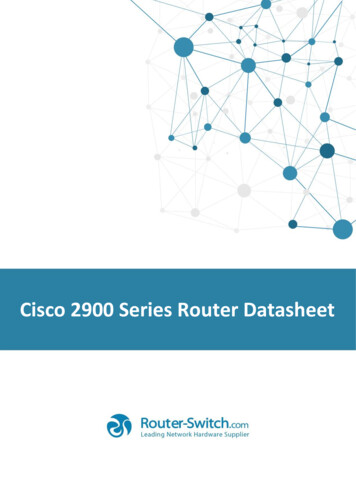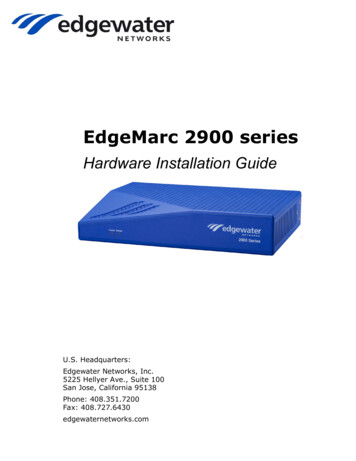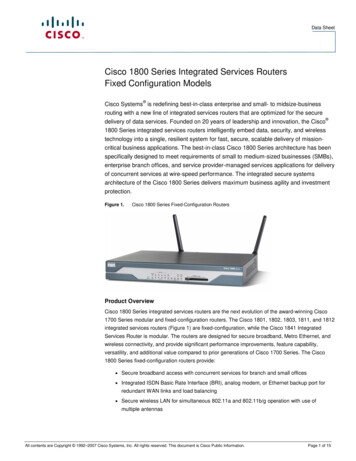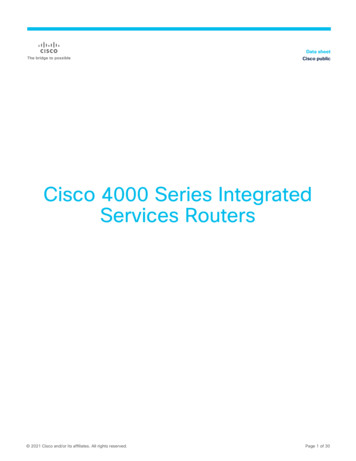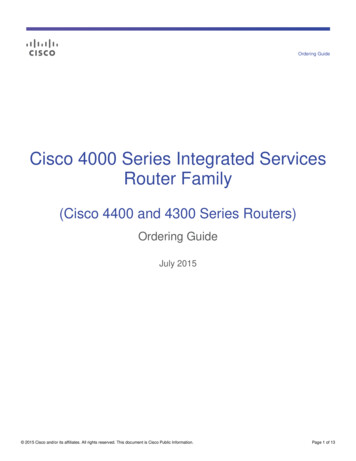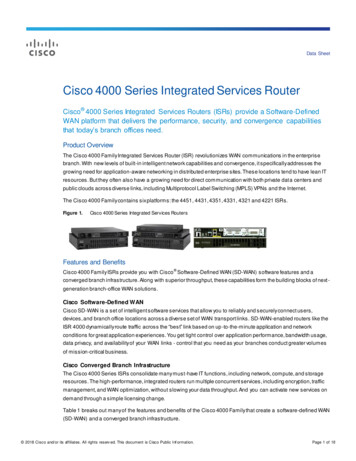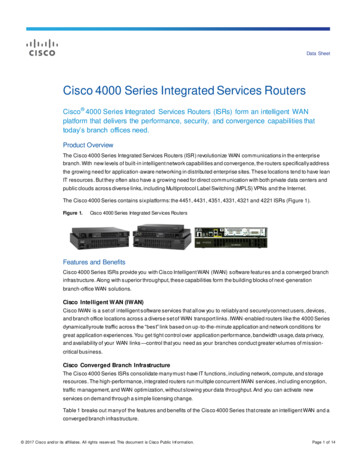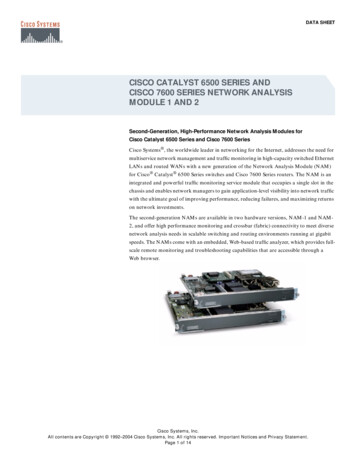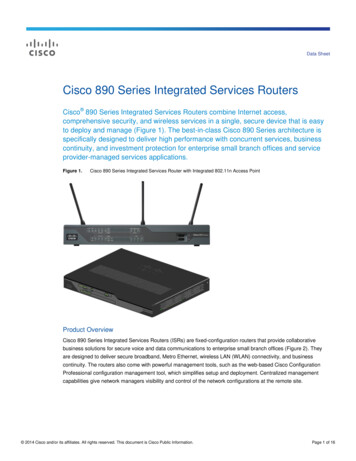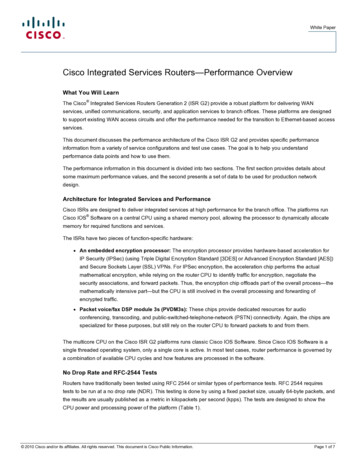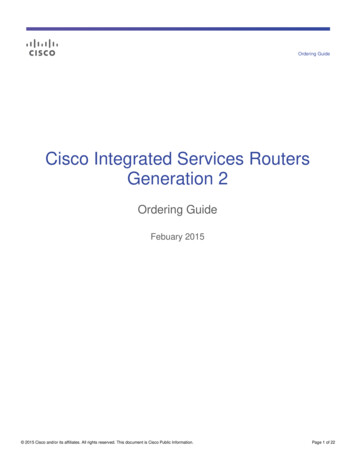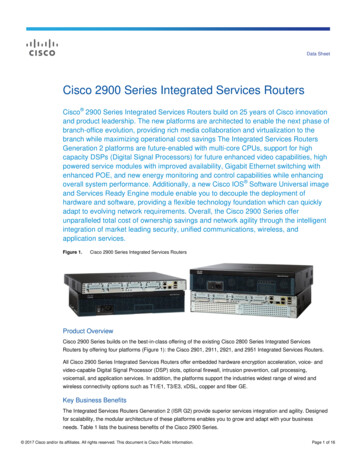
Transcription
Data SheetCisco 2900 Series Integrated Services RoutersCisco 2900 Series Integrated Services Routers build on 25 years of Cisco innovationand product leadership. The new platforms are architected to enable the next phase ofbranch-office evolution, providing rich media collaboration and virtualization to thebranch while maximizing operational cost savings The Integrated Services RoutersGeneration 2 platforms are future-enabled with multi-core CPUs, support for highcapacity DSPs (Digital Signal Processors) for future enhanced video capabilities, highpowered service modules with improved availability, Gigabit Ethernet switching withenhanced POE, and new energy monitoring and control capabilities while enhancingoverall system performance. Additionally, a new Cisco IOS Software Universal imageand Services Ready Engine module enable you to decouple the deployment ofhardware and software, providing a flexible technology foundation which can quicklyadapt to evolving network requirements. Overall, the Cisco 2900 Series offerunparalleled total cost of ownership savings and network agility through the intelligentintegration of market leading security, unified communications, wireless, andapplication services.Figure 1.Cisco 2900 Series Integrated Services RoutersProduct OverviewCisco 2900 Series builds on the best-in-class offering of the existing Cisco 2800 Series Integrated ServicesRouters by offering four platforms (Figure 1): the Cisco 2901, 2911, 2921, and 2951 Integrated Services Routers.All Cisco 2900 Series Integrated Services Routers offer embedded hardware encryption acceleration, voice- andvideo-capable Digital Signal Processor (DSP) slots, optional firewall, intrusion prevention, call processing,voicemail, and application services. In addition, the platforms support the industries widest range of wired andwireless connectivity options such as T1/E1, T3/E3, xDSL, copper and fiber GE.Key Business BenefitsThe Integrated Services Routers Generation 2 (ISR G2) provide superior services integration and agility. Designedfor scalability, the modular architecture of these platforms enables you to grow and adapt with your businessneeds. Table 1 lists the business benefits of the Cisco 2900 Series. 2017 Cisco and/or its affiliates. All rights reserved. This document is Cisco Public Information.Page 1 of 16
Table 1.Key Business Benefits of the Cisco 2900 Series Integrated Services RoutersBenefitsDescriptionServices Integration The Cisco 2900 Series ISRs offer increased levels of services integration with voice, video, security,wireless, mobility, and data services, enabling greater efficiencies and cost savings.Services On Demand A single Cisco IOS Software Universal image is installed on each ISR G2. The Universal image containsall of the Cisco IOS technology sets which can be activated with a software license. This allows yourbusiness to quickly deploy advanced features without downloading a new IOS image. Additionally, largerdefault memory is included to support the new capabilities. The Cisco Services Ready Engine (SRE) enables a new operational model which allows you to reducecapital expenditures (CapEx) and deploy a variety of application services as needed on a single integratedcompute services module.High Performance withIntegrated Services The Cisco 2900 Series enables deployment in high speed WAN environments with concurrent servicesenabled up to 75 Mbps. A MultigiGabit Fabric (MGF) enables high-bandwidth module-to-module communication withoutcompromising routing performance.Network Agility Designed to address customer business requirements, the Cisco 2900 Series modular architecture offersincreased capacity and performance as your network needs grow. Modular interfaces offer increased bandwidth, a diversity of connection options, and network resiliency.Energy Efficiency The Cisco 2900 Series architecture provides energy-saving features that include the following: The Cisco 2900 Series offers intelligent power management and allows the customer to control power tothe modules based on the time of day. Cisco EnergyWise technology will be supported in the future. Services integration and modularity on a single platform performing multiple functions, optimizes rawmaterials consumption and energy usage. Platform flexibility and ongoing development of both hardware and software capabilities lead to a longerproduct lifecycle, lowering all aspects of the total cost of ownership, including materials and energy use. High efficiency power supplies are provided with each platform.Investment Protection The Cisco 2900 Series maximizes investment protection: Reuse of a broad array of existing modules supported on the original Integrated Services Routersprovides a lower cost of ownership. A rich set of Cisco IOS Software features carried forward from the original Integrated Services Routersand delivered in a single universal image. Flexibility to adapt as your business needs evolve.Platform Architecture and ModularityThe Cisco 2900 Series is architected to meet the application demands of today’s branch offices with designflexibility for future applications. The modular architecture is designed to support increasing bandwidthrequirements, Time-Division Multiplexing (TDM) interconnections, and fully integrated power distribution tomodules supporting 802.3af Power over Ethernet (PoE) and Cisco Enhanced PoE (ePoE). Table 2 lists thearchitectural features and benefits of the Cisco 2900 Series.Table 2.Architectural Features and BenefitsArchitectural FeatureBenefitsModular Platform The Cisco 2900 Series ISRs are highly modular platforms with several types of module slots to addconnectivity and services for varied branch-office network requirements. The ISRs offer an industry-leading breadth of LAN and WAN connectivity options through modules toaccommodate field upgrades for future technologies without requiring a platform replacement.Processors The Cisco 2900 Series are powered by high-performance multi-core processors that can support thegrowing demands of high-speed WAN connections to the branch-office while also running multipleconcurrent services.Embedded IP Security (IPSec)VPN Hardware Acceleration Embedded hardware encryption acceleration is enhanced to provide higher scalability, which combinedwith an optional Cisco IOS Security license, enables WAN link security and VPN services (IPSecacceleration). The onboard encryption hardware replaces and outperforms the Advanced Integration Modules (AIMs) ofprevious generations.Multigigabit Fabric (MGF) The Cisco 2900 Series introduces an innovative Multi Gigabit Fabric (MGF) that allows for efficient moduleto-module communication, enabling tighter services interactions across modules while reducing theoverhead on the route processor. 2017 Cisco and/or its affiliates. All rights reserved. This document is Cisco Public Information.Page 2 of 16
Architectural FeatureBenefitsTDM Interconnectivity Fabric Unified communications services in the branch office are significantly enhanced with the use of a TDMinterconnectivity fabric in the system architecture, allowing for scaling of DS-0 channel capacity.Integrated Gigabit EthernetPorts All onboard WAN ports are 10/100/1000 Gigabit Ethernet WAN routed ports. One of the three 10/100/1000 Ethernet WAN ports on the Cisco 2921 and 2951 supports Small FormFactor Pluggable (SFP)-based connectivity in lieu of a RJ-45 port and enabling fiber connectivity.Innovative Universal-SerialBus (USB)-Based ConsoleAccess A new, innovative USB console port offers management connectivity for devices without a serial port suchas modern laptop computers. Traditional console and auxiliary ports are also available.Optional Integrated PowerSupply for Distribution of PoEand Universal DC PowerSupply An optional upgrade to the internal power supply provides inline power (802.3af-compliant PoE and CiscoInline Power) to integrated switch modules. On the Cisco 2911, 2921, and 2951, an optional DC power supply is available that extends deployment intocentral offices and industrial environments. On the Cisco 2911, an optional DC-PoE power supply is available.Optional External RedundantPower Supply (RPS) The Cisco 2911, 2921, and 2951 allow for power redundancy through the use of an external RPS device,thereby decreasing network downtime and protecting the network from power-supply failures. Redundant power on the Cisco 2900 Series is supported through the Cisco RPS 2300 Redundant PowerSystem. You can use the Cisco RPS 2300 to provide redundant power for Cisco 2900 Series ISRs as wellas Cisco Catalyst switches. In order to use the Cisco RPS 2300, an external RPS adapter is required (configurable option) to connectthe platform to the external RPS.PoE Boost When connected to an external RPS device, the Cisco 2911, 2921, and 2951 can operate in a PoE boostconfiguration in lieu of redundant power mode - whereby the power capacity of the platform is increased totwice the normal level to power additional PoE ports.Designed for FlexibleDeployments The Cisco 2911 and 2951 are designed for NEBS environments. The 2911 is 12” deep and has an optional fan filter for deployments in a variety of environments. Anassembly that provides front-to-back airflow is also available for 23” racks.Modularity Features and BenefitsThe Cisco 2900 Series provides significantly enhanced modular capabilities (refer to Table 3) offering investmentprotection for customers. Most of the modules available on previous generations of Cisco routers, such as theCisco 2800 Series, are supported on the Cisco 2900 Series. Additionally, modules can be used on other supportedCisco platforms to provide maximum investment protection. Taking advantage of common interface cards across anetwork greatly reduces the complexity of managing inventory requirements, implementing large network rollouts,and maintaining configurations across a variety of branch-office sizes.A complete list of supported modules, including a list of supported SFPs for the Cisco 2900 Series, is available at:https://www.cisco.com/go/2900.Table 3.Modularity Features and BenefitsISR ModulesCisco Service ModuleBenefits Each service module slot offers high-data-throughput capability: Up to 4 Gbps aggregate toward the route processor. Up to 2 Gbps aggregate to other module slots over MGF. Service Module (SM) slots are highly flexible with support for double-wide service modules (SM-Ds),which are Service Modules that require two SM slots. SM-Ds in the Cisco 2921 and 2951 provideflexibility for higher-density modules. A service module slot replaces the network module and the extension module for voice/fax (EVM) slotsand is offered on Cisco 2911, 2921, and 2951 ISRs. An adapter module enables backward compatibility with existing network modules, enhanced NetworkModules (NMEs), and EVMs. Service module slots provide twice the power capabilities relative to the network-module slots, allowingfor flexibility for higher-scale and better-performance modules. Power to service module slots can be managed by extensions similar to the Cisco EnergyWiseframework, so your organization can reduce energy consumption in your network infrastructure. FullEnergyWise support will be available in future software releases. 2017 Cisco and/or its affiliates. All rights reserved. This document is Cisco Public Information.Page 3 of 16
ISR ModulesCisco Enhanced High-SpeedWAN Interface Card (EHWIC)Benefits The EHWIC slot provides enhancements to the prior generation’s high-speed WAN interface card(HWIC) slots while provide maximum investment protection by natively supporting HWICs, WANInterface Cards (WICs), Voice Interface Cards (VICs), and Voice/WAN interface cards (VWICs). Four integrated EHWIC slots on the Cisco 2901, 2911, 2921, and 2951 allow for more flexibleconfigurations. Each HWIC slot offers high-data-throughput capability: Up to 1.6 Gbps aggregate toward the route processor. Up to 2 Gbps aggregate to other module slots over the MGF. Flexibility to support double-wide modules is enabled by combining two EHWIC slots. Up to 2doublewide HWIC (HWIC-D) modules are supported.Cisco Internal Services Module(ISM) A single ISM slot provides flexibility to integrate intelligent service modules on an internal slot withinthe chassis Each ISM slot offers high-data-throughput capability: Up to 4 Gbps aggregate toward the route processor. Up to 2 Gbps aggregate to other module slots over the MGF. The ISM replaces the AIM slot; existing AIM modules are not supported in the ISM slot. Power to ISM slots can be managed by extensions similar to the Cisco EnergyWise framework, so yourorganization can reduce energy consumption in your network infrastructure. Full EnergyWise supportwill be available in future software releases.Cisco High-Density Packet VoiceDigital Signal Processor (DSP)Module (PVDM3) Slots onMotherboard PVDM3 slots natively support PVDM3 modules, providing support for richer density for rich-media voiceand video. Each PVDM3 slot connects back to the system architecture through a 2 Gbps aggregate link throughthe MGF. Investment protection for PVDM2 modules is supported through an adapter module. Power to the PVDM slots can be managed by extensions similar to the Cisco EnergyWise framework,so your organization can reduce energy consumption in your network infrastructure. Full EnergyWisesupport will be available in future software releases.Compact Flash Slots Two external Compact Flash slots are available on the Cisco 2900 Series Integrated Services Routers.Each slot can support high-speed storage densities upgradeable to 4 GB in density.USB 2.0 Ports Two high-speed USB 2.0 ports are supported. The USB ports enable secure token capabilitiesand storage.Cisco IOS SoftwareCisco 2900 Series Integrated Services Routers deliver innovative technologies running on industry-leading CiscoIOS Software. Developed for wide deployment in the wo
Cisco 2900 Series builds on the best-in-class offering of the existing Cisco 2800 Series Integrated Services Routers by offering four platforms (Figure 1): the Cisco 2901, 2911, 2921, and 2951 Integrated Services Routers. All Cisco 2900 Series Integrated Services Routers offer embedded hardware encryption acceleration, voice- andFile Size: 770KBPage Count: 16
